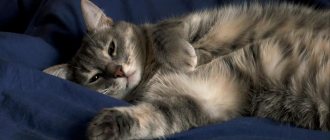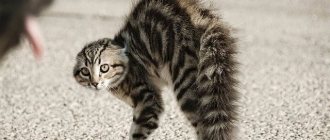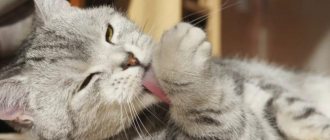9476Pavel
To achieve complete mutual understanding with your beloved cat, you must carefully observe the animal. Over the millennia spent next to humans, cats have learned to communicate with them in sign language. They signal their mood using various parts of their body, the most eloquent of which is its tail. A cat twitches its tail when it wants to tell its owner that it is hurt, scared or lonely. Often twitching indicates an incurable disease of the animal. Therefore, cat owners should know well what the pet’s various body movements mean and why he makes them. This will help to identify and fix the problem in time.
How cats communicate using their tail
In a cat society, the tail is simply irreplaceable. With the help of this part of the body, cats can express their attitude towards each other without uttering a sound.
Serious cat
The cat twitches its tail, and it is raised by a “pipe”
This is how the cat expresses pride in himself and his appearance. The cat feels confident in the circle of those present. Or the pet is very happy about the long-awaited meeting with the owners.
For your information! Showing self-confidence, cats can lick in front of unfamiliar animals and people.
The tip of the tail moves from side to side
This is how the animal shows curiosity, keen interest and some apprehension. This is usually how cats behave when meeting a new resident of the house.
Important! At the moment when the cat is excited, he is easily scared. Therefore, owners need to be careful not to frighten their pet. It is necessary to calm the kitten: pet it, scratch it.
If a cat looks around in fear and shakes its hooked tail, then something or someone is irritating it. Perhaps this is how the pussy tells its owner or pet that it does not intend to play or is not in the mood to communicate.
The fur on the tail is ruffled
In this situation, the cat is preparing to attack unexpectedly, so owners need to be vigilant. Perhaps, in this way, the cat is honing its hunting skills through play, or the pet is very irritated.
Annoyed cat
Pathological causes of head tremors in cats
If a cat's head twitches, then special attention should be paid to the health of the cat. In some cases, a veterinarian diagnoses serious illnesses. Common cat diseases include:
- Otodectosis. This cat disease is popularly called ear scabies. The animal develops parasites in the ear cavity. At the same time, the pet begins to actively shake its head and furiously scratch its ears with its paw. The causative agent is a small mite that bites into the tissue of the shell. The cat experiences severe itching, and while scratching it makes a plaintive meow. Upon careful examination of the ear cavity, the owner can identify abrasions and scratches. In the depths, black and brown discharge is recorded, consisting of dried blood and waste products of parasites. Banal cleaning of the ear canal does not have a positive result. The pet continues to experience extreme discomfort from otodectosis;
- Sulfur plug. The accumulation of wax forms plugs in the ear canal. The cat's hearing decreases and he begins to shake his head strangely, trying to remove the foreign particle;
- Otitis media. This is an inflammatory disease. The ears begin to hurt very much and fester. If your cat's head is trembling, and the animal does not allow you to examine the sore spot, then it may be a cold. The owners note a purulent odor from the ears and the discharge of a purulent mass. It is necessary to take your pet to a veterinarian;
- Diseases of a neurological nature. Tremor can be observed with encephalitis, stroke, dizziness, and head injury. In this case, you need to carefully monitor the pet’s behavior and its general condition. If accompanying symptoms are recorded, such as unsteadiness while walking, movements in a circle, pupils of different sizes, diagnostics in the clinic is required;
- Liver, kidney or multiple organ failure. The condition clearly indicates a failure in the normal functioning of the organ. This disease is very difficult for pets to tolerate. In this state, the cat jerks its head strangely. The pathology leads to the death of the four-legged friend. Tremor occurs in most cases in the last stages, before which the animal feels unwell and its former activity disappears. At the first sign, you need to take your pet to the veterinary clinic.
Why do cats shake their tail?
Watching the cat, breeders wonder why the cat develops new behavioral characteristics - the tail is shaking. To give an accurate answer, you need to understand the details of this phenomenon.
The cat is coughing: why it wheezes, the reasons, as if it was choking
A restless cat holds his tail in a horizontal position. If a cat's tail occasionally trembles and he looks around in fear, with his ears pressed to his head, this indicates the animal's alertness. If there is an object of irritation in the room, then it should be removed from the cat’s field of view, otherwise the animal may panic, and the further outcome of the actions of a frightened animal is unpredictable.
Note! But if the tail sways from side to side, you need to be prepared for a sudden attack by your pet, however, such a command from a pet does not always foreshadow a threat. Similar habits can be observed while playing with an inanimate object. Cats, parading their ancestors, attack their toy.
Cats, like humans, can express doubt when they need to make a choice. Living for several thousand years side by side with people, the descendants of tigers began to adopt some of the habits of the supreme being. While in thought, a person can rhythmically tap his fingers on the table or swing his leg. Likewise, a cat, which is faced with a choice, begins to involuntarily twitch the tip of its tail; the pussy holds the base of the tail straight. Moreover, in such a situation, only the tail is involved, that is, no other peculiarities in the cat’s behavior are observed. To stop flinching, you just need to help your pet make a choice.
The cat also twitches its tail, expressing a feeling of satisfaction. When the cat is calm, fed, and happy, he slowly raises the tip of his tail up and down. Also, such behavior indicates reciprocal feelings for the owner’s affection, so a representative of the cat family expresses gratitude to a person, and the cat purrs and, perhaps, rubs against the owner’s hands, walks around the owner. In addition, by twitching its tail, the cat informs others that what is happening in the room completely satisfies it.
Often the reason for a wagging tail is interest. Movements of the tail are carried out slowly and to the beat, but the general appearance of the animal remains unchanged, all the cat’s attention is focused on one object. This usually happens after the owner goes to the store; in such a situation, the subject of the cat’s examination becomes a bag of food. A pet, showing interest in something, watches with caution, sniffs, carefully examines the object, sometimes engrossed in its occupation, and prevents the owner from passing.
Note! To accurately determine why your beloved cat's tail is shaking, you need to be attentive to details, namely, the environment in which the animal is located, the general appearance of the cat and the pet's surroundings at the moment.
Diseases
If you notice a deterioration in the general condition and that the cat is walking with its tail between its legs, it is worth observing the accompanying symptoms. When blood sugar levels drop, the animal will appear scared and depressed. In a mild form, the cat presses its tail to its stomach, trembles, and mostly lies down. If help is not provided, the animal's base body temperature drops and convulsions begin. Within a few hours, the cat falls into a pre-coma state and dies. Hypoglycemia is often diagnosed in purebred cats, which are actively used for breeding.
Similar behavior can occur with low hemoglobin levels. Anemia does not lead to death within a few hours, but it is no less dangerous for the pet’s body. Low hemoglobin is a lack of red blood cells, called red blood cells. The role of these cells is very important - they carry oxygen throughout the body, delivering it to all organs and tissues. When there are not enough red blood cells, the cat experiences oxygen starvation from the inside, meaning it breathes and its body suffocates.
An allergic reaction to food or other irritants can lead to general tremors, weakness, increased or decreased temperature, suffocation and a number of other consequences. In this state, the cat tucks its tail, does not eat, drinks poorly, and hides in secluded places. Itching, swelling of the mucous membranes, and increased secretion of tears and saliva are often observed. The condition can be treated with antihistamines, which should be prescribed by a veterinarian.
Trauma – fracture or bruise. In the second case, the consequences are unpredictable, since a spinal fracture often damages the spinal cord. In case of injury, a hematoma forms at the site of the impact, which can impinge on the nerve endings. If there is a risk that the cat has injured its tail, contacting the veterinarian should not be delayed. The injured area is examined by x-ray and only after that, the doctor prescribes treatment.
The cat is shaking its tail: what is its mood?
Why is the kitten shaking as if he is cold?
Like people, cats have a body language that can be used to determine the animal’s state of mind. So, the owner, by looking at the cat, can understand whether the cat wants to play, or whether it is better to leave the pet alone.
- If a cat intends to play with a person, he expresses this with a slight twitch of his tail directed vertically upward. If during play the cat begins to loudly lash the floor with its tail, then everything should be stopped.
- A pet's irritation can be easily determined by the nervous twitching of its tail in different directions. Sometimes an indicator of an irritated state is a tail raised up, with its tip bent in a hook.
- Another reason for tail shaking is a feeling of stress, some fear. Your pet may be experiencing pain. If a cat is worried about something, it usually taps its tail on the floor with small shot, and the general appearance of the animal is full of thoughtfulness. To eliminate the possibility of your pet becoming ill, it is necessary to examine the animal as soon as possible and take appropriate measures.
- If the fur on the cat's back is tousled and the tail flicks from side to side, you must be careful and attentive when interacting with your pet, as the animal may suddenly attack.
The cat is shaking
It is absolutely impossible to notice the appearance of tremors in a pet. Sometimes you can’t see it (small tremors), but if you just touch the cat’s body with your hand, it will be felt.
Trembling can also be severe, with it the limbs usually begin to twitch intensely, this is very noticeable in hairless breeds of cats, as well as smooth-haired ones. It is impossible to confuse such a symptom with others (for example, with a cramp). Many owners, seeing that their beloved cat is trembling like a leaf, immediately, without finding out all the reasons, fall into a state of panic.
There is no need to panic, but this case should not be overlooked either. Before going to the nearest veterinary clinic, having previously placed the cat in a carrier, you should read the relevant information about tremors in cats, which can be found on many forums on the Internet.
Communication with the eyes.
The eyes are wide open and looking straight at you - the cat is all attention, interested in what you say or do.
Eyes half closed - this is drowsiness, calmness or caution, indicates a friendly disposition - this is a signal of trust and affection
Half-closed eyes indicate drowsiness, calmness or caution; they indicate a friendly disposition - this is a signal of trust and affection. Pupils like slits - aggressiveness, which means the cat is on guard and confident in itself
Pupils like slits - aggressiveness, which means the cat is on guard and confident.
The eyes twinkle and blink - the cat expresses his gratitude.
The vision is clouded, the third eyelid - the cat may be sick or relaxed, or offended.
The cat stares at you - this is a challenge, keep your distance.
If the cat crouches to the ground and does not look at you, this is submission.
Facial expression.
Cats are unique: they are able to demonstrate two completely opposite emotions - fear and aggressiveness - at the same time.
A cat can also express irritation along with fear, and can show real horror, accompanied by expressions on the face, complete submission and incredible aggressiveness.
Lip licking is a sign of concern or interest, especially when the cat quickly licks its lips exactly twice and at the same time looks warily at the person or object that is bothering it.
Symptoms
Symptoms of feline hyperesthesia can develop at any age, and the condition can occur in all breeds. A cat that suffers from hyperesthesia syndrome may end up licking and biting its own body, such as its limbs, tail and back.
Expert opinion
Slanimsky Alexey Georgievich
Veterinarian of the highest qualification category. Has extensive experience in diagnosing and treating diseases in animals.
Important! It is still not known for certain why this disease occurs, but it regularly burns nerve cells for cat breeders. As a rule, the manifestations of this pathology can be managed with sedatives, which your veterinarian can prescribe to your cat.
Here are some other signs that your cat may have hyperesthesia:
- The skin on your cat's back may range from the shoulders to the tail
- Your cat may suddenly jump and turn towards her tail as if something is bothering her
- You may notice muscle twitching, tail twitching, and/or muscle spasms
- Your cat may not like certain areas of its back to be touched when you go to pet it
- Your cat may act erratically, appear agitated, and have dilated pupils
- Your cat may cry, hiss, or suddenly run away, and you may think she's hallucinating because she looks like she's going after something that isn't there.
- Severe cases can lead to self-destruction through chewing, licking, fur pulling, and biting. As a result, lesions and infections may appear on the skin.
Typically, these symptoms occur in episodes that may last only a few seconds or a few minutes. In between episodes, your kitten will act as if everything is fine. However, touching your cat in the wrong place can trigger an episode.
Treatment according to symptoms
Tremor caused by external manifestations does not require therapeutic intervention; it is enough to minimize the factors that cause the pet to tremble. If the cause of trembling is:
– hypothermia: warm the animal, dry the fur (if necessary), stroke it, give a light massage of the paws and body;
– overheating: use a cold compress, provide your pet with plenty of water:
– stress: calm your pet down, let him lie down for a while and pet him unobtrusively, give him a treat and protect him from the factor that causes fear;
– sexual heat: be attentive to the condition of your pet, consult a doctor about the possibility of using drugs that reduce sexual activity;
– sleep: if the cat trembles all over at rest, wait for the pet to wake up, or, as a last resort, wake him up;
Lack of stress eliminates the occurrence of tremors in pets
If you notice regular tremor of the whole body and limbs in your pet, you should contact a veterinarian and undergo a full clinical examination at a veterinary clinic. This will help to quickly identify the source of pathology and prescribe the necessary treatment.
Treatment includes the prescription of medications - sedatives and anthelmintics, symptomatic and antimicrobial therapy. The presence of neoplasms, pathologies and disorders of the nervous and musculoskeletal system are indications for surgical intervention. In the future, the animal will need additional examination and careful care.
Causes
It is important to determine the reason why the animal twitches its back and tail. To do this, you should carefully observe the cat.
The reasons can be both harmless and dangerous.
Safe Reasons
Cats have vibrissae, which are sensitive hairs in their fur, such as whiskers. On the back they are stiffer than the rest of the hair and may be white. They are designed for orientation in space. If you touch them, the animal will twitch the hair on its back. If you run it against the grain and ruin her hair or ruffle it, she will also twitch and then begin to lick herself, putting herself in order.
If your cat jerks its back or tail, it will be under stress. When she is scared, excited, nervous, she shows her condition by twitching. This phenomenon can often be observed during the mating season. Especially when the animal does not have the opportunity to walk and look for a partner for procreation. You can also observe twitching when she wants to go to the toilet. She may start running, meowing, and freaking out. Thus, by twitching the skin, the animal establishes peristalsis. This is normal behavior for her and should not cause alarm to her owners.
Dangerous reasons
Twitching of the skin on the back can be a sign that your cat's health is deteriorating. In such a situation, the main thing is not to delay and contact a specialist. The veterinarian will order tests, make a diagnosis and prescribe treatment.
A pet may jerk its back due to diseases such as:
- Rabies;
- Hyperesthesia syndrome;
- Cancerous tumors;
- Fleas.
If a cat roams freely on the street, it runs the risk of encountering another animal with rabies. The disease is transmitted through a bite. If you notice that your cat's back is twitching, he has attacks of aggression, is irritable, eats food but does not drink water, immediately take him to the doctor. These are symptoms of rabies.
If the disease is neglected, it will become dangerous for all family members. An animal infected with rabies can infect humans. If the symptom is confirmed by the veterinarian after tests, the cat will be euthanized. Unfortunately, veterinarians have not yet found effective treatment methods that can restore health to a pet.
Some young cats, under one year of age, develop hyperesthesia syndrome. Most often, purebred animals are susceptible to it. It is difficult to treat due to the fact that it has not been fully studied. The syndrome is accompanied by hypersensitivity and increased nervousness. The cat's condition changes from normal to aggressive, suddenly, as if a switch in her brain was switched. She can attack other animals or people. Biting your own tail. Small children should not be allowed near to protect the child from being bitten and scratched.
The first call is when the animal begins to take extra care of its fur. It constantly licks itself in the area of the back and tail. Such excessive care can lead to dermatitis, severe itching of the skin. In a cat in this condition, not only does the skin on its back twitch, but its hair also falls out, forming bald patches. The disease can be aggravated by a fungal infection. Treatment of hyperesthesia syndrome is carried out with special medications against seizures and sedatives.
A cat may twitch its back nervously, itch, and lick itself intensively due to fleas. Even if she is indoors and does not go outside, there is a risk of infection. People can bring them on their shoes. There are special drops and collars to combat them.
If a tumor forms in the spinal cord, the cat may nervously jerk its back. Treatment is carried out through surgery. This disease is rare, but the prognosis for the affected animal is disappointing.
Noticing symptoms in time is a step towards recovery. You can't run them. The veterinarian needs to be told about all the nuances of the animal’s behavior. Then the correct diagnosis will be made and the correct treatment will be prescribed.
Why does the animal run and nervously lick itself?
Licking is normal for cats. These clean animals are so sensitive to the cleanliness of their fur that they lick themselves at every opportunity: after eating, going to the toilet, or being touched by their owners. Moreover, by licking their fur coat, they calm down. Licking can be talked about as a normal phenomenon only when it is not fanatical in nature. Why does a kitten or adult cat run around the house and lick nervously?
The cat is stressed
These animals have a very vulnerable psyche. It doesn’t take much for a pet to lose its peace of mind. This can happen due to a trip in a car, a visit to the veterinarian, quarrels in the family, the appearance of a new four-legged inhabitant in the house, moving to another room, changing place of residence, etc. All cats experience stress differently. Some begin to run aimlessly around the apartment and fanatically lick the fur. Sometimes they do this so violently that in some areas of their bodies they become completely bald.
As soon as the factor that provoked the cat’s emotional shock disappears or he gets used to new circumstances, the pet will stop being nervous. However, cats are not always able to overcome stress on their own. Sometimes they need sedatives.
Hyperesthesia syndrome
This rather rare disorder, affecting the skin, neuromuscular and nervous systems, is most often detected in kittens. The reasons for its appearance are unknown, but it is believed to be due to disruption of neurotransmitters in the brain during anxiety.
Animals with this syndrome feel tense all the time and experience increased sensitivity to touch. Their spine and tail are the most vulnerable. They lick the fur too diligently, paying special attention to the most vulnerable areas of the body, sometimes leading to the appearance of bloody wounds. Hyperesthesia syndrome can also be recognized by other symptoms:
- nervous tail beating;
- twitching of parts of the body in the back;
- sudden bursts of activity, sometimes developing into aggression;
- dilated pupils;
- tail biting;
- loud meow.
The cat has fleas, worms or other parasites
The reason for this behavior may be ecto- and endoparasites. They cause the pet a lot of suffering. Especially unbearable for them is the endless itching in places affected by external parasites, such as fleas. It prevents the tailed poor fellows from sleeping peacefully, eating, and spending time carefree. In order to somehow drown it out, they begin to rush around the house and actively lick the irritated skin, often only aggravating the situation.
Having noticed symptoms of a helminthic infestation in a cat, it is necessary to take measures to destroy the pests as quickly as possible. Antiparasitic drugs, especially if they are planned to be used to treat a kitten, should be discussed with your veterinarian.











